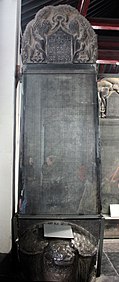Seleucid era
(Redirected from
Anno Graecorum
)Anno Graecorum
An example from China: the Syriac text at the bottom of the Xi'an Stele mentions that the stele was erected in the "Year of the Greeks 1092" (781 AD), at the imperial capital city of Chang'an (modern-day Xi'an).[1][2][3]
The Seleucid era ("SE") or Anno Graecorum (literally "year of the Greeks" or "Greek year"), sometimes denoted "AG," was a
Parthians. It is sometimes referred to as "the dominion of the Seleucidæ," or the Year of Alexander. The era dates from Seleucus I Nicator's reconquest of Babylon in 312/11 BC after his exile in Ptolemaic Egypt,[4] considered by Seleucus and his court to mark the founding of the Seleucid Empire. According to Jewish tradition, it was during the sixth year of Alexander the Great's reign (lege: possibly Alexander the Great's infant son, Alexander IV of Macedon) that they began to make use of this counting.[5] The introduction of the new era is mentioned in one of the Babylonian Chronicles, the Chronicle of the Diadochi.[6]
Versions
Two different variations of the Seleucid years existed, one where the year started in spring and another where it starts in autumn:
- The natives of the empire used the Babylonian calendar, in which the new year falls on 1 Nisanu (3 April in 311 BC), so in this system year 1 of the Seleucid era corresponds roughly to April 311 BC to March 310 BC. This included the inhabitants of Coele-Syria, notably the Jews who call it the Era of Contracts (Hebrew: מניין שטרות, romanized: minyān shəṭarot).
- The Tishri.[8]
These differences in the beginning of the year means that dates differ by one if they fall between spring and autumn. Notably, the Jewish historical book
Elias Bickerman
gives this example:
- For instance, the restoration of the temple of Jerusalem by Judas Maccabaeus, approximately 15 December 164 BC, fell in the year 148 of the Seleucid Era according to Jewish (and Babylonian) calculation, but in the year 149 for the court.[11]
Later usage
The Seleucid era was used as late as the sixth century CE, for instance in the
Gorpiaios, 823 (24 September, 512 AD),[12] and in the writings of John of Ephesus.[13] Syriac chroniclers continued to use it up to Michael the Syrian in the 12th century AD / 15th century AG.[7] It has been found on Central Asian tombstones of Christians belonging to the Church of the East well into the 14th century AD.[14]
The Seleucid era counting, or "era of contracts" (minyan shəṭarot), was used by
David ben Zimra's cancellation of the practice when he served as Chief Rabbi of Egypt.[17]
References
- ISBN 978-3-643-90329-7.
- Adam the Deacon, son of Jazedbuzid, Vicar-episcopal. The Lord Sergius, Priest and Vicar-episcopal. Sabar Jesus, Priest. Gabriel, Priest, Archdeacon, and Ecclesiarch of Cumdan and Sarag.
- ^ Wilmshurst, David. A Monument to the Spread of the Syrian Brilliant Teaching in China (PDF). p. 9.
- ^ Denis C. Feeney, Caesar's Calendar, University of California Press, Berkeley 2007, p. 139.
- ^ Babylonian Talmud (Avodah Zarah 10a), Rabbeinu Hananel's Commentary; RASHI's commentary on Babylonian Talmud (Avodah Zarah 9a); Sefer Hakabbalah of Rabbi Avraham ben David (Ravad); Midrash David on Mishnah Tractate Avot (Ethics of the Fathers, 1:6)
- ^ Babylonian Diadochi Chronicle (BCHP) 3 Archived 2017-07-22 at the Wayback Machine; obverse, line 4.
- ^ a b Andrew Palmer (1993). The Seventh Century. Liverpool University Press. pp. xxxiv, xxxvii, lii–lviii.
- ^ Emil Schürer, Geschichte des jüdischen Volkes im Zeitalter Jesu Christi, vol. 1, Leipzig 1886–1890; 4th edition 1901–1909, pp. 36–46; Mishnah, Rosh HaShanah 1:1
- ^ Schürer, Emil (1890). A History of the Jewish People in the Time of Jesus Christ. T&T Clark. pp. 36–44.
- ISBN 0521323525.
- Bickerman, Elias J. (1943). "Notes on Seleucid and Parthian Chronology". Berytus. 8: 73–84.
- ^ M. A. Kugener, Nouvelle Note Sur L'Inscription Trilingue De Zébed, Rivista degli Studi Orientali (1907), pp. 577-586.
- American Historical Review, 52:1 (1946), p. 82.
- ^ "Syriac Gravestones from Central Asia". Archived from the original on 2001-04-08. Retrieved 2012-01-19.
- )
- Babylonian Talmud, Avodah Zarah 10a, which reads: “Said Rav Nahman: 'In the Diaspora, it is not permissible to count [the date in years] except only by the kings of the Grecians'.”
- ^ Chaim Yosef David Azulai, Shem ha-Gedolim [Ma'arekhet Gedolim], ed. Yitzhak Isaac Ben-Yaaqov, (the Letters Daleth), Vienna 1864, s.v. מהר"ר דוד ן' זמרא, p. 19 (section 16 - ז) (Hebrew)
Bibliography
- Robert Harry van Gent. The Babylonian Calendar. Has a date converter based on Parker & Dubberstein (1971).
- ISBN 9780674976931.
- Kosmin, Paul J. (7 May 2019). "A revolution in time". aeon. Retrieved 12 January 2020.
Once local and irregular, time-keeping became universal and linear in 311 BCE. History would never be the same again.
- Strootman, Rolf (2015). "Seleucid Era". Encyclopaedia Iranica. Leiden: Brill. Retrieved 14 May 2021.



